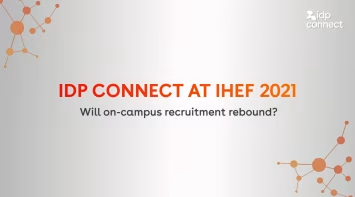As another recruitment cycle kicks into full gear, I am having more and more conversations with my university clients about messaging. Everyone realizes the need to differentiate their communication with international students from what traditional domestic audiences might receive, but few have the bandwidth to dig deep and analyze if their current communication flow is meeting the expectations of what overseas students want to hear.
Over the next few months, we’ll be identifying some of the key needs and expectations of international students and how your institution can pre-emptively answer these questions as part of your communication flow messaging. First up, let’s tackle the ever important (but seldomly explored) topic of outcomes.
Gauging student interests
For many years, prospective international students have sought answers during their college searches as to what a degree from their intended institution might lead to: jobs in the U.S., further graduate study, or preparation for a career back in their home country. Numerous surveys of prospective and currently enrolled students indicate that career possibilities ranked at or near the top of major influencers on decisions about where to attend. Since 2005, the International Student Barometer (ISB) report, produced by i-Graduate, annually gathers more than 4 million students’ feedback on a variety of destination countries about their experiences during the search and enrollment process. This data helps institutions shape recruitment strategies and keeps an ear open to what is impacting the student decision making process.

Source: International Student Barometer report, 2021, i-graduate
From the ISB report: “employability attracts, it supports students’ happiness and helps integrate domestic and international students. It also matters for recommendation, turning graduates into brand ambassador alumni.”

Source: International Student Barometer report, 2021, i-graduate
For the third year in a row, the 2021 ISB report for North America-bound international students (see above graphic) indicated that career impact ranked top as the main motivation for selecting particular colleges or universities. Prior to this recent surge, institutional reputation had ranked as the top factor.
Changing times
Gen Z students’ career choices are in flux as a result of the pandemic, according to a recent INTO survey where 53% of students reported changes to their career goals over the past two years . Interestingly, 45% of these international students indicated they wished to start their own businesses. COVID-19 has sharpened the awareness of students as to their places in the world, how they learn, and how their futures might look different as a result of the global impact of this pandemic.
In the last year, two of the major pathway providers have launched career-focused content as part of their offerings for prospective international students. Shorelight Education has its Career Accelerator Program that helps teach overseas students at their US-based partner universities the professional skills they need to find and secure internships and jobs after graduation. Meanwhile, Study Group recently launched for UK and European-based international students a range of services to help students prepare for and obtain internships and job placements.
Conveying your value
Colleges and universities that are responsive to the needs of current international students put themselves in an enviable position when it comes to turning those successes with placements into future student messaging. While most colleges have some form of a career services or professional development office on campus, very few have unique services for international students (other than CPT/OPT forms to initiate internal processes with the ISSS office). Even for those colleges without specific international offerings, talking up the CV/resume workshops, interview prep sessions, and internship/job fair access on campus is essential and something every communications flow should include.
Career services offices typically will have internship and job placement rates for graduating classes, but very few have data on specific outcomes for international graduates. If your campus does capture that granular level detail, great. If not, share what you do have available. Show the proof of success in securing employment. Of course, outcomes may not always be jobs but can also include further graduate study. Is that data readily available to you?
Which companies have a strong track record of hiring international alumni from your institution? One simple way to start gathering that information from future job and internship fair employers is to ask them: Do/will you hire international students for CPT/internships and/or OPT/jobs after graduation? By simply having the career services office add those questions to the application form for companies to respond to, you can begin building a list. A next step to promote those job openings would be to build an RSS feed (pulling this data from career services) on your international site that will show the most recent openings where employers have indicated that international students are encouraged to apply for available positions. The feed can be set up to refresh each night to provide students the most up-to-date open positions.
Lastly, your institution likely has students who are currently taking advantage of curricular or optional practical training (CPT or OPT). If so, there is an easy opportunity to work with your designated school officials (DSOs) on campus to mine those current records for the companies that have most recently hired international students. Make this at least an annual, if not semi-annual, exercise to gather this invaluable content and real-world examples of where your degrees can lead. In the end, if you can partner with your alumni office to gather the names and contact details of successful international alumni and capture their testimonials in various formats, you will have a series of fresh content ideas to pass along to prospective students overseas. By sharing those real stories and painting the picture of what lengths your college goes to help students facilitate desirable outcomes, you will add tremendous value to your messaging campaigns.
You might like...

Q&A with James Smurthwaite: Getting prospective students excited about studying abroad
In this series of interviews we get to know some of our IDP experts who often operate behind the scenes.

Q&A with Rachel MacSween, Director of Client Partnerships UK and Europe at IDP Connect
In our latest Q&A, Rachel talks all things HE and why the sector continues to inspire her

Counsellor Q&A: Thai perspectives on studying in the UK and attracting more Thai students to UK institutions
Specialist advice from our education counsellors for the Thai student market



